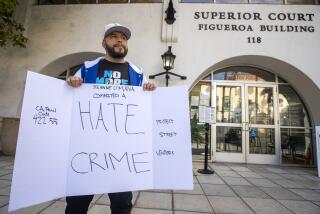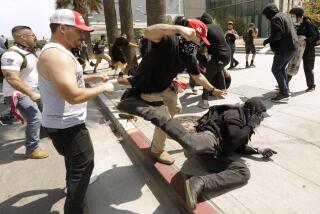What’s behind Albuquerque police shooting protest and cyber attack?
What started as a peaceful protest over Albuquerque police involvement in a series of fatal shootings escalated into what the mayor called “mayhem” as cops and demonstrators clashed on Sunday. While tensions have been building for a while in the New Mexico city, the latest confrontation illustrates the continuing power of the Web and Internet groups to move beyond electrons into the streets, highlighting how the politics of protest has changed. Here is a primer to the issues.
What happened on Sunday?
Hundreds of protesters, responding to a call from cyber-activists, took to the streets to protest 37 police shootings – 23 of them fatal – since 2010. The protests began around noon and moved through the city before it was finally dispersed by midnight. Police fired at least two rounds of tear gas, according to local media reports. There were a handful of arrests for disorderly conduct; property was damaged; and at least one officer was injured and another officer was trapped in his vehicle, Mayor Richard Berry told reporters.
Is the city trying to stop all protests?
No, but the city does want to limit the damage. Mayor Berry made that point on Sunday when he said he was proud of how police they handled the protest. “We want people to be able to protest, obviously they have their 1st Amendment rights to do that, but what it appears what we have on our hands now is a smaller group of individuals whose main goal is not to protest but to put the public and themselves in danger.”
If the shootings began in 2010, why the protests now?
What seems to have shifted the debate was a call by the hacking collective known as Anonymous to attend Sunday’s protest. The group posted a video on YouTube threatening to wage cyber war against the police following the March 16 killing of a homeless man that inflamed passions. Police confirmed that their website has been breached by an unknown group.
How common is a cyber attack?
Anonymous is a named used by hactivists since roughly 2003 when groups launched a series of “denial of service” attacks in the United States and Europe designed to bring companies and other institutions to their computer knees. Credit card firms, government agencies and disliked groups such as police have all been targeted. Anonymous has been derided as cyber terrorists and praised as digital Robin Hoods. Dozens of people have been arrested and charged over the years and some have been jailed.
How else has the Internet been used?
In addition to the cyber attacks, activists of all stripes have used the communication power of the Web to spread their protests. The Occupy movement protesters, often featuring the distinctive Guy Fawkes mask made popular again by Anonymous, spread in part because of their electronic skills. Activists have also used the organizing power of the Web, spreading petitions that have led to prosecutions as in the case of the Steubenville, Ohio, athletes convicted in connection with the sexual assault on a woman.
What lies ahead in New Mexico?
Federal officials are investigating the March 16 shooting and the Justice Department is investigating the whole pattern of police actions. Meanwhile, the Web remains a wild card with more attacks on police computers a possibility, as are demonstrations.
Follow L.A. Times National News on Facebook
ALSO:
4.8 earthquake is Yellowstone’s largest in 34 years
Washington landslide’s official death toll rises to 21; 30 missing
Sante Fe police dig up new leads -- and bones -- in 1952 cold case
More to Read
Start your day right
Sign up for Essential California for news, features and recommendations from the L.A. Times and beyond in your inbox six days a week.
You may occasionally receive promotional content from the Los Angeles Times.







